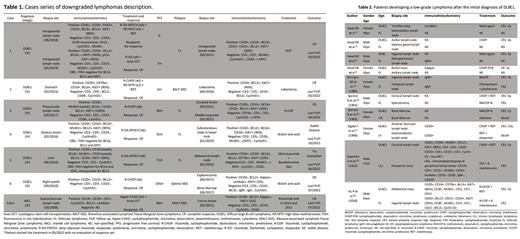Abstract
Introduction: Diffuse large B-cell lymphoma (DLBCL) is the most common non-Hodgkin's lymphoma (NHL) in clinical practice. It can arise as a transformation of another indolent B-cell lymphoma, but the development of a low-grade lymphoma after the diagnosis and treatment of a DLBCL is a much rarer phenomenon called downgraded lymphoma.
Aim and Methods: We reported six rare cases of low-grade NHL development after the initial diagnosis and treatment of a DLBCL (Table 1) with a literature review on other cases of downgraded lymphomas from 1980 to 2022 (Table 2), and described another rare case of a Mantle Cell Lymphoma (MCL) relapsing as a MALT-type Marginal Zone Lymphoma (MALT MZL).
Case Series:
Case 1: a 67-year-old (yo) male diagnosed with a refractory DLBCL in April 2019, after treatment with R-DA-EPOCH (dose adjusted rituximab, etoposide, prednisone, vincristine, cyclophosphamide, doxorubicin). He underwent rescue treatment with R-ICE (rituximab, ifosfamide, carboplatin, etoposide) followed by autologous stem cell transplantation (ASCT) in August 2019, presenting a complete response (CR). By November 2019 he relapsed with a localized Follicular Lymphoma (FL), been treated with local radiotherapy (RDT) and developing a second CR by March 2020.
Case 2: a 32-yo male diagnosed with DLBCL in February 2015 who received 8 cycles of R-CHOP (rituximab, cyclophosphamide, doxorubicin, vincristine, prednisone) presented a post-treatment PET-CT maintaining hypermetabolism in the left femur, been treated with local RDT. By January 2016 he relapsed with a pleural lesion compatible with BALT-type Marginal Zone Lymphoma (BALT MZL). Patient underwent lobectomy in June 2016, presenting a new CR.
Case 3: a 77-yo male was diagnosed with DLBCL with extranodal involvement of the skin, stomach and bone marrow in February 2017. He was treated with 6 cycles of R-CHOP from March to July 2017 with a CR. In February 2021, he relapsed with a FL and underwent a R-COP (rituximab, cyclophosphamide, vincristine, prednisone) regimen for 6 cycles developing another CR.
Case 4: a 48-yo male underwent a R-DA-EPOCH treatment for a DLBCL diagnosed by February 2016, achieving CR. In January 2019, he evolved with subcutaneous nodules in the left upper limb in addition to left inguinal lymphadenopathy. A biopsy was performed with results compatible with a FL but with no indication of treatment due to the low volume of disease.
Case 5: a 72-yo male diagnosed with a DLBCL in June 2016 underwent a R-DA-EPOCH regimen for 6 cycles, relapsing as FL in April 2022 after splenomegaly investigation and retroperitoneal abdominal lymph nodes biopsy. He started treatment with Obinutuzumab and Bendamustine in June 2022.
Case 6: A 50-yo female with a diagnosis of a cutaneous primary DLBCL treated with 4 cycles of ProMACE-CytaBOM (cyclosphosphamide, doxorubicin, etoposide, bleomycin, vincristine, methotrexate, and prednisone) associated with local RDT. The patient evolved with splenomegaly and cytopenia, being diagnosed with a splenic MZL with bone marrow infiltration in June 2017 but kept on watch and wait.
Extra Case: a 45-yo male with a previous 2007 diagnosis of MCL treated with 4 cycles of Hyper-CVAD (cyclophosphamide, vincristine, doxorubicin, dexamethasone, methotrexate, cytarabine) followed by ASCT in 2008, with no maintenance afterwards. The patient was held on watch and wait from 2008 until May 2015, when he underwent a routine colonoscopy with visualization of lesions compatible with MALT MZL. He was then treated with 4 cycles of Rituximab monotherapy evolving with a new CR.
Discussion and Conclusion: In these 7 cases the anatomopathological exams of both the diagnosis and in the relapse were reviewed and confirmed the downgrading phenomenon, without any evidence of a transformation prior to the initial treatment. We found other ten previously reported cases of downgraded lymphoma after successful treatment of underlying DLBCL in literature. More studies should verify the possibility of low-grade DLBCL transformation and what prognosis this downgrading would bring to the patient. Comparison of pre and post-transformation biopsy material from the same individual is a prerequisite for understanding the molecular mechanisms of phenotypic changes in lymphoma.
Keywords: Downgraded Lymphoma, Diffuse Large B-cell Lymphoma, Low-grade Lymphoma.
Disclosures
No relevant conflicts of interest to declare.
Author notes
Asterisk with author names denotes non-ASH members.


